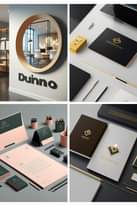Logo design has evolved significantly over the years, with modern brands rethinking traditional approaches to create unique and impactful visual identities. From the humble beginnings of simple monograms and emblems, to the digital age of dynamic and versatile logos, the evolution of logo design reflects the changing nature of branding and consumer preferences.
In the early days of branding, logos were primarily used as a means of identifying a product or company. This led to the development of monogram logos, where a company would use its initials or acronym to create a simple and recognizable symbol. These logos were often designed to be timeless and easily reproducible, using traditional techniques such as lettering and engraving.
As technology and design tools progressed, logos became more intricate and diverse. Emblem logos emerged, combining textual elements with graphical symbols to create a more impactful and memorable visual identity. These logos were often used by companies looking to convey a sense of prestige and heritage, using elaborate illustrations and ornate typography to communicate their brand values.
In recent decades, the rise of digital design has led to a shift in logo trends. Modern brands are now rethinking traditional logo design approaches, creating versatile and dynamic visual identities that can adapt to different digital mediums and platforms. This has seen the emergence of minimalist and geometric logos, which rely on clean lines and simple shapes to convey a brand’s message in a concise and contemporary manner.
Furthermore, the rise of the internet and social media has propelled brands to consider how their logos will appear on various digital platforms, leading to the development of responsive logos that can adapt to different screen sizes and resolutions. This has seen a move towards more simplified and adaptable designs, with an emphasis on scalability and recognizability across different mediums.
Another major shift in logo design is the focus on storytelling and brand narratives. Modern brands are rethinking traditional logo design by creating visual identities that encapsulate their brand’s values, mission, and story. This has seen the emergence of narrative logos, which use symbolic imagery and illustrative elements to convey a brand’s personality and essence.
The evolution of logo design reflects the changing landscape of branding and consumer preferences. Modern brands are rethinking traditional logo design approaches to create dynamic, versatile, and impactful visual identities that resonate with today’s digitally savvy consumers. As technology and design tools continue to advance, the future of logo design is likely to see even more innovative and imaginative approaches to visual identity creation.




